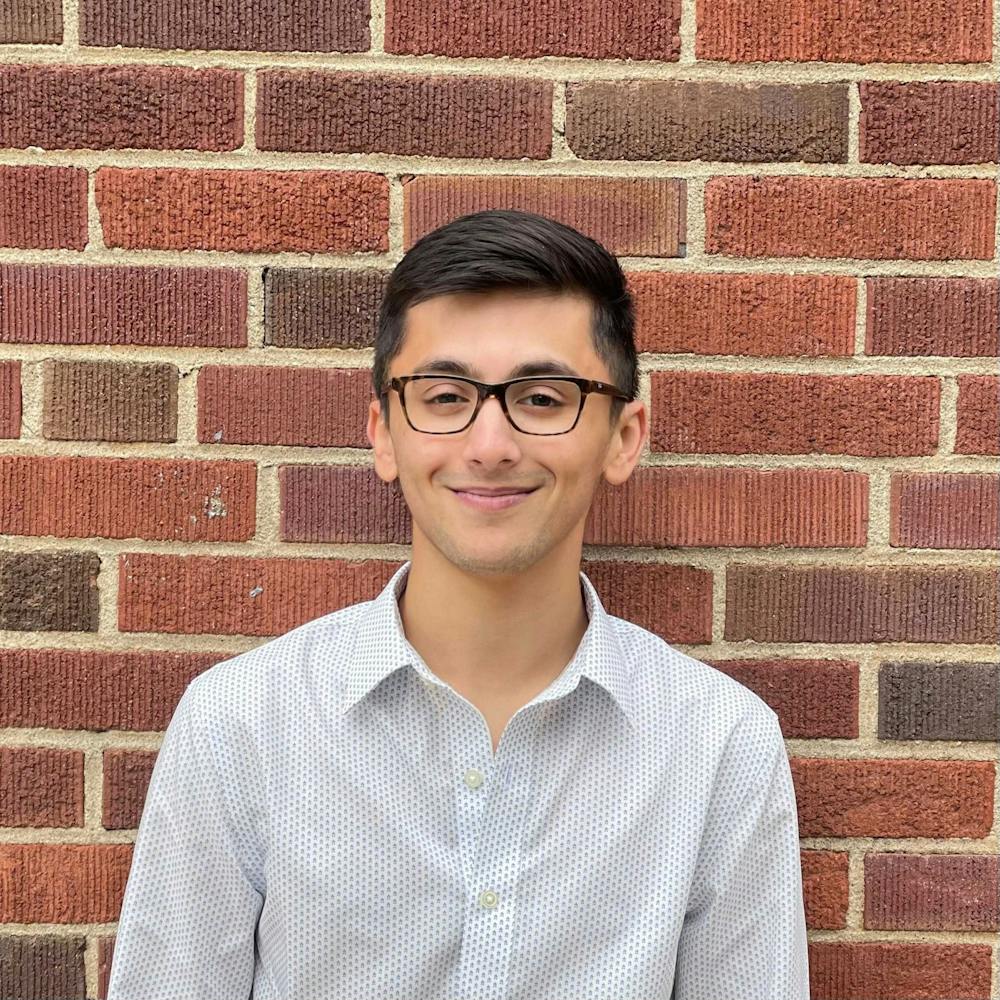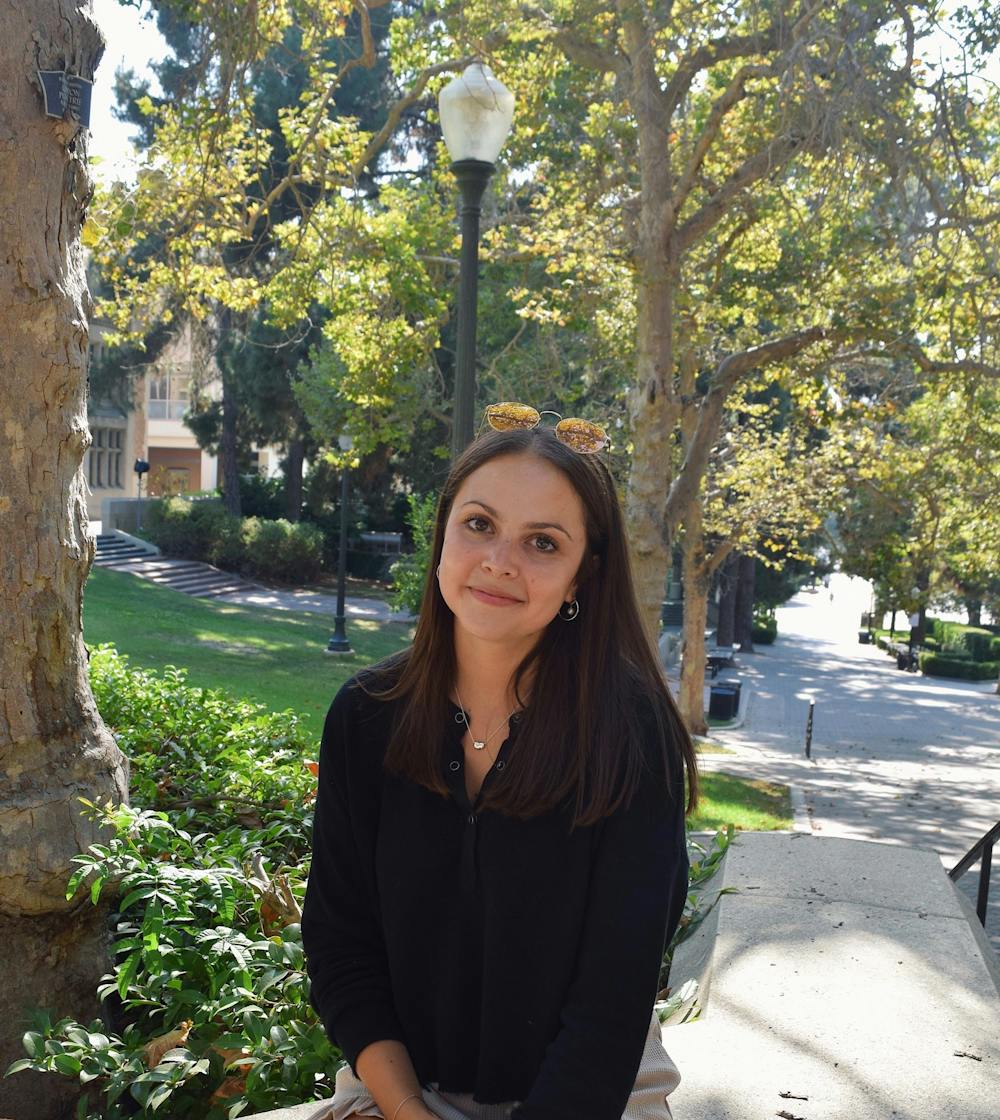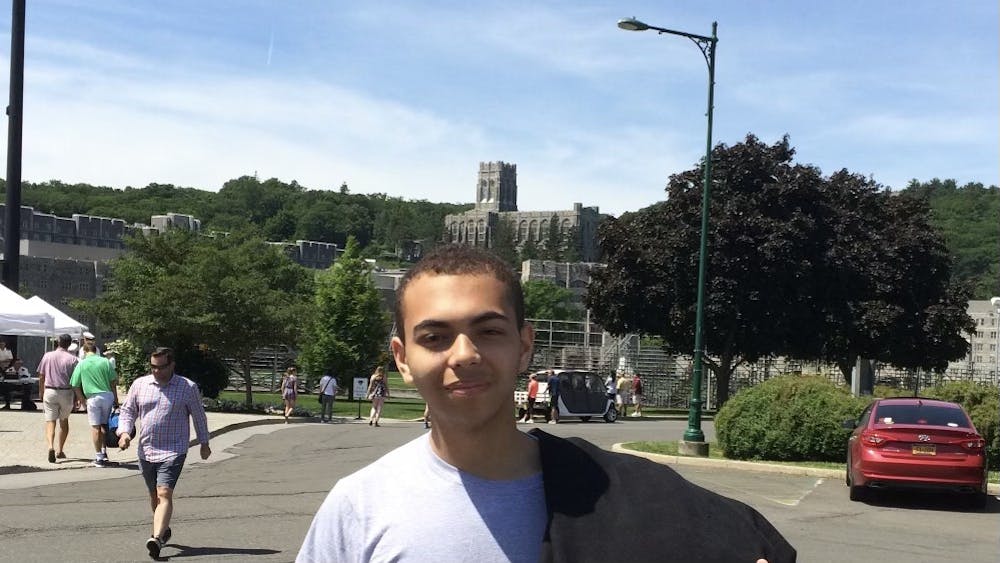COVID–19 stole a lifelong dream from Nicholas Anane (C’ 24), who has wanted to attend college at West Point since middle school. But after contracting COVID–19 in March 2020, he has suffered from long–term symptoms that made enlisting no longer an option. Instead, he came to Penn.
“You can’t be a good soldier if your lungs are busted,” he says. Nicholas emphasizes that joining the military despite his long COVID symptoms would endanger himself and others, which he didn’t want to risk.
In the two years after his first infection, Nicholas became infected with COVID–19 twice more—in July 2021 and December 2021. Each time, he’s experienced a fever, cough, congestion, sore throat, nausea, and ear pain. And ever since his 2020 acute infection, he’s also struggled with brain fog and extreme fatigue, sometimes even falling asleep briefly when he doesn’t intend to.
His fatigue is severe, especially when sitting for long periods—he once even fell asleep during an exam. “I’ll just all of a sudden, maybe ten to 15 minutes in, I’ll be unable to stay awake,” he says.
Of the 236 million people worldwide diagnosed with acute COVID–19, more than half will experience long–term symptoms like Nicholas, a phenomenon known as “long COVID.” The Centers for Disease Control and Prevention estimates that only 1 in 4 COVID–19 cases have been reported, meaning the true number of infections—and long COVID patients—is unknown.
At Penn, 5,249 members of the University community have tested positive for COVID–19, and many of them experience ongoing symptoms. Student Health Service Medical Director Vanessa Stoloff says that although there isn’t a distinct set of diagnostic criteria for long COVID, SHS likely has encountered these patients at Penn.
Now, two years after the first wave of lockdown orders, mask mandates and other restrictions are being lifted nationwide, and weekly case counts in the United States decreased by 28.8% in early March. Philadelphia recently lifted indoor masking requirements, moving the city’s COVID–19 status to All Clear.
But even as the masks come off, students continue to suffer from long COVID—chest tightness, brain fog, migraines, loss of taste and smell, shortness of breath, fatigue—months after recovering from their acute infections. Though the threat of COVID–19 seems to be fading, the remnants of the disease still linger for many—including members of the Penn community. These are their stories.
Akash Chauhan (E ‘24) is another Penn student who’s experienced long COVID after testing positive in November 2020. Akash is from Maryland, but he spent his gap year in Nevada doing an internship, where he contracted COVID–19.
His roommate worked in a nursing home and had to get tested weekly, but didn’t believe in COVID–19. After testing positive, she lied to Akash, telling him that she had tested negative.
During his acute infection, Akash lost his sense of taste and smell very quickly. It was different from other illnesses—he wasn’t congested, but he still had difficulties tasting and smelling. His symptoms mimicked those of the common cold, but were slightly more severe.
“I had no ability to discern [tastes]. I could drink vinegar. I had really spicy food,” he says. “It’s like the connection between my tongue and my mind just broke.”

Though his main symptoms cleared up in about a week, Akash struggled with decreased lung capacity, shortness of breath, fatigue, and increased heart rate—especially while exercising—for about three months after contracting COVID–19. These symptoms have since resolved.
His sense of taste and smell returned at around 60–70% shortly after recovering from the acute infection. Now, almost 16 months later, Akash estimates his senses to be 80% normal. He adds that even though it may not seem like a lot, losing 20–30% of your senses is “a pretty substantial difference.”
“Now, nothing is horrible. Nothing tastes horrible, nothing smells that bad. But nothing is also that good or amazing anymore,” he says, noting that it’s frustrating not being able to enjoy food as much, especially when he goes out to eat.
Simultaneously, Akash feels that his diminished sense of taste and smell has brought some benefits.
“I can just eat whatever I want, and only care about its nutrition content and how many calories it has and how much protein it has,” he says. His breakfast usually consists of a smoothie of multiple protein powders, bananas, blueberries, broccoli, peanut butter, and a raw egg.
“I can very much optimize my diet and my lifestyle,” Akash concludes.
In addition to loss of taste and smell, other long COVID symptoms include fatigue, migraines, and shortness of breath.
This is the case for Emma Bollinger (C ‘22), who got COVID–19 in April 2021, around the beginning of the Delta variant surge. She had been fully vaccinated for a month at the time.
When Emma first developed symptoms, she thought she had a sinus infection. Though an unvaccinated member of her dance group had tested positive, Emma didn’t expect to also be COVID–positive because she was vaccinated. At the time, many medical experts believed that it was highly unlikely for vaccinated individuals to contract COVID–19.
At midnight after the day she was tested, Emma got a text that she had received a red PennOpen Pass. She wasn’t sure if it was because she was being contact traced, or if she had tested positive, since she hadn’t received her results yet. She ultimately ended up testing positive.
Since her symptoms had already been present for three days, her quarantine lasted seven days, during which she stayed in her room in her off–campus apartment, and her roommates brought her food. None of Emma’s roommates tested positive, despite the fact that they all “live on top of each other.”

Photo courtesy of Emma Bollinger
With final exams approaching, Emma planned to complete all her assignments in isolation, then relax after they were over. However, she was so fatigued that she slept for most of her time in isolation. Her other symptoms included chest tightness and diminished taste, both of which cleared up within a few days.
Penn called Emma every day to monitor her symptoms. Her case was particularly novel, as not many vaccinated individuals had contracted COVID–19 at that point.
After recovering from the acute infection, Emma’s symptoms persisted. A sufferer of chronic migraines, she expected them to occur during her isolation, but they never did. Afterward, however, her migraines increased from three to four per month to every other day. Almost a year later, they are still occurring at this frequency.
Emma also experienced memory problems and difficulty concentrating, which fall under the umbrella of “brain fog.”
For these symptoms, Emma has seen a primary care doctor and a neurologist at Penn Medicine’s neurology long COVID clinic. Most of her medical care has consisted of symptom monitoring, though she did recently receive nerve block injections in her head to help with migraine pains. Emma is just one of many patients who have sought care for lasting symptoms of COVID–19—a virus whose long term impacts in the human body are still only beginning to be understood.
Dr. Matthew Schindler, assistant professor in Penn Med’s Neurology department, is one of the physicians that runs the neuro–focused COVID long–hauler clinic that Emma visited for her symptoms.
Noticing a trend in persistent neurological symptoms after an acute COVID–19 infection, Dr. Schindler and colleagues Dr. Dennis Kolson, Dr. Danielle Sandsmark, and Dr. Sara Manning Peskin started the long COVID neurology clinic to specifically address this issue.
Schindler says that Manning Peskin spearheaded the program, as many of the patients were initially referred to her, particularly through Penn Med’s Post–COVID Assessment and Recovery Clinic.
When the clinic began in April 2021, there was initially a large backlog of those who had contracted COVID–19 since early 2020. Almost a year later, the clinic has seen over 300 people, receiving around eight to ten new patients each week.
The clinic serves patients who are experiencing either new or worsened neurological symptoms following an acute COVID–19 infection. Schindler says that symptoms persisting for two months after the acute infection can generally be considered long–haul COVID symptoms.
Emma says her long–term symptoms were the worst for the first three months after her acute infection: May to July 2021. She usually enjoys dancing and working out, but had trouble participating in these activities because of post–COVID fatigue and chest tightness. She was also taking a lot of migraine medicine, which can cause drowsiness.
Now, Emma is fortunately able to dance and work out, having no difficulty at her weekly four–hour dance rehearsal. However, she still struggles with brain fog and says she has approximately 14 migraines a month.
Schindler says that symptoms of brain fog and migraines are some of the most common seen in the clinic, along with dizziness. Some of the symptoms that can be categorized as brain fog, which Schindler says is a “nebulous term” in the medical field, include overwhelming fatigue, memory problems, or difficulty paying attention.
“We really don’t have very good treatments for brain fog pharmaceutically. It’s not like we have something that can make people smarter or make their memory better,” Schindler adds. “We do sometimes try medicines to help out with fatigue.”
In terms of dizziness, patients most commonly report “vestibular symptoms,” which encompass feelings of imbalance, disequilibrium, or vertigo. Other neurologic symptoms Schindler has seen include numbness or weakness, as well as anxiety and depression.
While some patients present with only one symptom, Schindler estimates that over 50% of patients have multiple, and most experience all three of the main symptoms—brain fog, headache, and dizziness. Because long COVID is extremely novel, it’s difficult to pinpoint the physiological cause of the symptoms, as well as comorbidities that could be exacerbating them.
“We’re kind of working on limited knowledge, and we all have different backgrounds, but we're all in it together,” Schindler says.
Schindler and his colleagues meet weekly or biweekly to ensure they are updated on the literature and are adapting to the ever–changing science of long COVID. While the symptoms and recovery are different for each patient, he observes that improvement occurs more quickly in long COVID patients than in other cases requiring neurologic rehabilitation, such as stroke or traumatic brain injury. Still, challenges persist.
“What’s really hard is quantifying the impact on somebody's day–to–day function. A lot of people describe waxing and waning symptoms, some days are better than others,” Schindler adds.
When a patient visits the neuro–focused long COVID clinic, they are first asked about their medical history, then their acute COVID–19 infection. The majority of the appointment focuses on their post–COVID symptoms. Staff members perform various tests, including a neurologic exam that tests cognitive function.
From this information, the physician decides what tests or scans need to be run in order to devise the best treatment plan. There is no standardized treatment for long COVID, so Schindler and colleagues are using a combination of physical and cognitive therapies.
“We’re targeting therapies depending on what the primary symptoms are,” he says. “I’ve had a lot of my patients really, really enjoy it, particularly the cognitive therapy. They felt like they got a lot out of that. I think our therapists do an excellent job.”
Schindler explains that the clinic sees a diverse range of patients. While some contracted COVID–19 before the availability of vaccines, others were infected more recently.
For those who contracted COVID–19 early in the pandemic, he wonders if they had severe symptoms but were not hospitalized due to the overwhelming patient loads faced in 2020. Others with mild acute infections also have come to the clinic with long–term symptoms. For some, the persisting symptoms began during their acute infections, while others did not report such symptoms until a few weeks later.
Although the clinic has not seen many patients who were hospitalized in the intensive care unit (ICU), Schindler hypothesizes that patients who were in the ICU have presented with more severe neurologic dysfunction.
“If somebody was in the ICU—in our clinic, that’s been the minority of patients that we’ve seen—I think they have more severe neurologic dysfunction post–COVID,” he says. “That’s not surprising either, as anyone who stays in the ICU is generally at higher risk for more cognitive dysfunction following it.”
He also notices that older patients are taking longer to recover than younger patients, though this is also not surprising that age brings about other comorbidities that affect cognitive function. Cognitive dysfunction can also be difficult to quantify, because the level of mental strength needed on a daily basis varies between a college student and retired individual, for instance.
Academically, long COVID has certainly affected Emma and Nicholas.
When fall semester rolled around, Emma spoke with her professors about her long–term post–COVID symptoms. Since many of her classes were small discussion–based seminars, she let them know that she may zone out or need additional time to process content. She says that her professors were all understanding.
Nicholas also spoke with his professors, who he says were “very kind.” He experiences fatigue and sleepiness, especially when a task requires a lot of concentration or effort. “Sometimes I’ll even forget what I’m saying [mid–]sentence,” Nicholas says.

Photo courtesy of Nicholas Anane
Neither Emma nor Nicholas ended up using any accommodations such as extended time on exams, though Nicholas changed his major from economics to philosophy and Emma dropped her senior thesis.
In addition to Penn’s academic accommodations, Counseling and Psychological Services (CAPS) offers a chronic illness support group. Nicholas has also sought support from CAPS to discuss his fatigue and develop coping mechanisms, which he maintains was helpful—even though wait times were long.
“It definitely was frustrating last semester because of how slow the process was, but I also figured there were kids in far worse situations than I was,” he adds.
Nicholas urges others to consider the COVID–19 pandemic on a larger scale, and also expresses his frustration regarding pandemic–related politics.
“Even if it’s not about yourself, there are still others you have to consider,” he says. “This is a matter of life and death for a lot of people.”
Talking to Emma about how long COVID has changed her perspective on the pandemic, the word “frustrated” also comes up a lot. While she understands that many people are perfectly fine after having COVID–19, she’s seen a completely different side of contracting the virus.
“Last semester sometimes I literally couldn’t go out because I felt so ill, and it’s hard for people to understand that I’m not lying when I say I don’t feel well. It’s not that I don’t want to go out. I actually physically can’t,” says Emma. “Because they were fine after having COVID, it doesn’t make sense to them. That’s really frustrating to me.”
It was difficult to see people take the pandemic lightly after it had impacted her life so much. “[Having long COVID] did make me more scared, and it made me frustrated when people didn’t care,” says Emma.
Akash, however, has a different take. He also contracted COVID–19 once more after his November 2020 infection.
“I’m glad I’m on the other side. I’ve had it twice. I don’t have to be afraid of anything,” he says. “I’m pretty over living in fear and acting like we’re going to have to do this for the rest of our lives.”
Though Akash’s second acute infection occurred after he was vaccinated, he feels protected by the shots. He emphasizes his belief that the risk of complications from a COVID–19 is minimal for fully vaccinated individuals.
While data show that vaccination can decrease chances of severe cases, hospitalizations, and long COVID, the exact decrease in risk is difficult to quantify. Vaccinated individuals continue to contract breakthrough infections, which have resulted in some hospitalizations or long–term COVID–19 symptoms for vaccinated patients, such as Emma, particularly with new variants of the virus. Though Akash’s pandemic fatigue is a common sentiment, particularly among “college students [who just] want to party and have fun,” COVID–19 precautions are still vital for protecting those vulnerable to the virus.
Emma implores her peers to challenge the perception that young people come away from COVID–19 infections with no long–term effects.
“Everyone thinks it’s going to happen to old people or people with pre–existing health conditions, which I have neither of. I’m a young healthy person who exercises, and it affected my life a lot,” she explains. “It’s hard for people to understand, which has been the most frustrating thing.”
Nicholas simply hopes that a lesson will be learned from the pandemic.
“I think we’ll get through this,” Nicholas says. “Perhaps this generation will understand a little more that every second they have is something to be grateful about.”
Although Nicholas, Akash, and Emma have seen their long–term symptoms get better with time, they’re not completely gone. Schindler underscores that it’s reassuring to see improvement in patients’ long COVID symptoms.
“We are seeing people recover. We are seeing people get better. It’s slow, it’s at their own pace, it’s not the same for every individual, but we are seeing people recover,” he says. “There is some kind of light at the end of the tunnel.”
